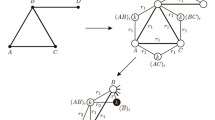Abstract
The NP-hardness in the strong sense is proved for two problems of cognitive data analysis. One of them is the problem of taxonomy (clustering), i.e., splitting an unclassified sample of objects into disjoint subsets. The other is the problem of sampling a subset of typical representatives of a classified sample that consists of objects of two images. The first problem can be considered as a special case of the second problem, provided that one of the images consists of one object. The function of rival similarity (FRiS-function) is used, which assesses the similarity of an object with the closest typical object, to obtain a quantitative quality estimate for the set of selected typical representatives of the sample.

Similar content being viewed by others
REFERENCES
N. G. Zagoruiko, I. A. Borisova, V. V. Dyubanov, and O. A. Kutnenko, “Methods of recognition based on the function of rival similarity,” Pattern Recognit. Image Anal. 18 (1), 1–6 (2008).
I. A. Borisova, V. V. Dyubanov, N. G. Zagoruiko, and O. A. Kutnenko, “Similarity and compactness,” in Proc. All-Russ. Conf. Math. Methods Pattern Recognit.-14 (Suzdal, Russia, September 21–25, 2009), (Maks Press, Moscow, 2009) 89–92 [in Russian].
C. J. C. Burges, “A tutorial on support vector machines for pattern recognition,” Data Mining Knowl. Discovery 2 (2), 121–167 (1998).
M. Tipping, “The relevance vector machine,” in Adv. Neural Inf. Process. Syst. (Morgan Kaufmann, San Mateo, CA, 2000).
N. G. Zagoruiko, Applied Methods of Data and Knowledge Analysis (Izd. Inst. Mat., Novosibirsk, 1999) [in Russian].
K. V. Vorontsov and A. O. Koloskov, “Compactness profiles and prototype object selection in metric classification algorithms,” Iskusstv. Intell. (2), 30–33 (2006).
M. N. Ivanov and K. V. Vorontsov, “Prototypes selection based on minimization of complete follow control functional,” in Proc. All-Russ. Conf. Math. Methods Pattern Recognit.-14 (Suzdal, Russia, September 21–25, 2009), (Maks Press, Moscow, 2009) 119–122 [in Russian].
S. Bermejo and J. Cabestany, “Learning with Nearest Neighbor Classifiers,” Neural Proc. Lett. 13 (2), 159–181 (2001).
V. N. Vapnik, The Task of Learning Pattern Recognition (Znanie, Moscow, 1971) [in Russian].
N. G. Zagoruiko, I. A. Borisova, V. V. Dyubanov, and O. A. Kutnenko, “A quantitative measure of compactness and similarity in a competitive space,” Sib. Zh. Ind. Math 13 (1), 59–71 (2010) [J. Appl. Ind. Math. 5 (1), 144–154 (2011)].
I. A. Borisova, “Taxonomy algorithm FRiS-Tax,” Nauchn. Vestn. NGTU (3), 3–12 (2007).
I. A. Borisova and N. G. Zagoruiko, “FRiS-TDR algorithm for solving a generalized taxonomy and recognition problem,” in Proc. All-Russ. Conf. Knowl.-Ontology-Theory, KONT-09 (Novosibirsk, Russia, October 22–24 2009) (Novosibirsk, 2009), 1, 93–102 [in Russian].
J. MacQueen, “Some methods for classification and analysis of multivariate observations,” in Proc. 5th Berkeley Symp. Math. Stat. Probab. (California, June 21–July 18, 1965 and December 27, 1965–January 7, 1966) (California Univ. Press, California, 1967), 1, 281—297.
A. V. Zukhba, “NP-completeness of the problem of prototype selection in the nearest neighbor method,” Pattern Recognit. Image Anal. 20 (4), 484–494 (2010).
I. A. Borisova, V. V. Dyubanov, O. A. Kutnenko, and N. G. Zagoruiko, “Use of the FRiS-function for taxonomy, attribute selection and decision rule construction,” in Proc. First Int. Conf. KONT 2007 (Novosibirsk, Russia, September 14–16, 2007) and First Int. Conf. KPP 2007 (Darmstadt, Germany, September 28–30, 2007) Revised Selected Papers. Lect. Notes Comput. Sci. (Springer, Heidelberg, 2011), 6581, 256–270.
N. G. Zagoruiko, I. A. Borisova, O. A. Kutnenko, and V. V. Dyubanov, “A construction of a compressed description of data using a function of rival similarity,” Sib. Zh. Ind. Mat. 16 (1), 29–41 (2013) [J. Appl. Ind. Math. 7 (2), 275–286 (2013)].
I. A. Borisova, “Computational complexity of the problem of choosing typical representatives in a 2-clustering of a finite set of points in a metric space,” Diskretnyi Anal. Issled. Oper. 27 (2), 5–16 (2020) [J. Appl. Ind. Math. 14 (2), 242–248 (2020)].
M. R. Garey and D. S. Johnson, Computers and Intractability: A Guide to the Theory of NP-Completeness (Freeman, San Francisco, 1979; Mir, Moscow, 1982).
Funding
The study was carried out within the framework of the state contract of Sobolev Institute of Mathematics, project no. 0314–2019–0015.
Author information
Authors and Affiliations
Corresponding author
Additional information
Translated by V. Potapchouck
Rights and permissions
About this article
Cite this article
Kutnenko, O.A. Computational Complexity of Two Problems of Cognitive Data Analysis. J. Appl. Ind. Math. 16, 89–97 (2022). https://doi.org/10.1134/S1990478922010082
Received:
Revised:
Accepted:
Published:
Issue Date:
DOI: https://doi.org/10.1134/S1990478922010082




